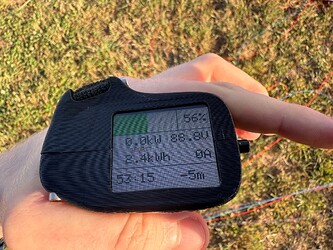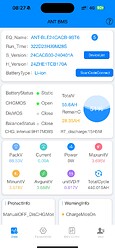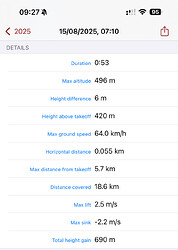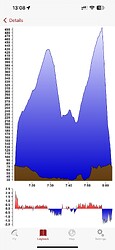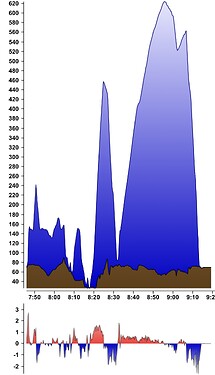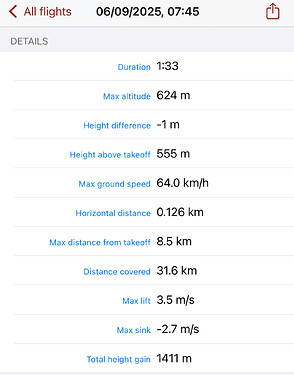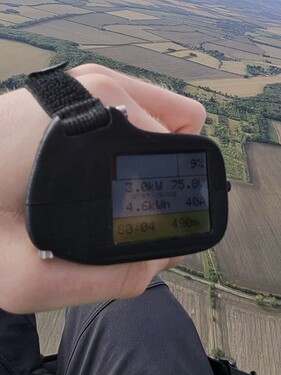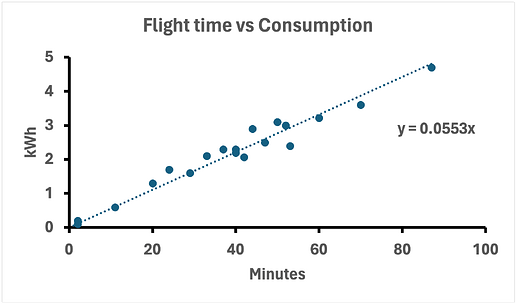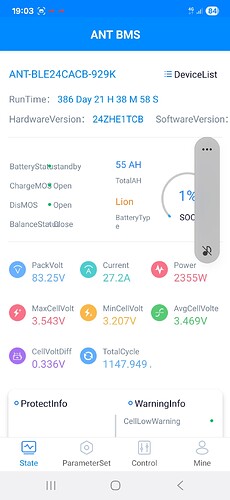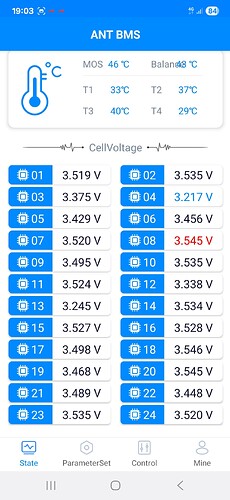The Mojo6 is relatively slow (32-35km/h) and I don’t have knee or back pain yet so landings are ok.
It’s the nil wind takeoffs that are a pain. If I mess up 1-2 attempts it gets exhausting ![]()
I have similar slow boat wing it is 25m epic motor from bgd. nill wind I also had issue with. then watch sky school videos. lay wing out perfect ( fold tips in). then go forward so you can feel lines. step 3 steps back and bull rush forward and continue run. and short after go to full power when angle of wing is around 60. works like a charm. from bull rush to power is around 5 sec and only 1 more sec or max 2 sec you go to full power
Well, all the equipment is 40kg to 42kg. She might be around 58 to 60kg. She is strong because she is lifting 2/3 of her bodyweight on her back ![]() I am almost twice her weight… Which means I would have to run with almost 80kg on my back. Doable yes but definitely not fun.
I am almost twice her weight… Which means I would have to run with almost 80kg on my back. Doable yes but definitely not fun.
Hat off to her ![]()
you duffus its a male. picture mann with a beard. an he is 65 kg.
A couple things to keep in mind that makes this flight time overestimated. The percentage is an indicator of what voltage the battery is at and the voltage drops faster at the end of the discharge. You also need to take into account voltage sag. When the battery has a load the voltage drops lower than the resting voltage. When you let off the throttle the voltage recovers. The system will shutdown when the voltage sags down to the low voltage limit. So you can’t use the last little bit of capacity unless you are high and use just enough throttle to slow your decent but not enough throttle to sag the voltage to the lower limit.
If he is looking at the BMS for the data, then it will be pretty accurate. The older version HC V2.0 and below don’t pull the data from the BMS, so it’s just guessing based on the total voltage.
But with the 4.8kWh battery and if it’s correct that he is charging at 3kW then an hour and 30 minutes is totally realistic.
Also as the SOC calculation for the BMS is not based on voltage and instead based mainly on Ah in and out then you can fly down to 0% without the risk of it shutting off because of voltage sag. I regularly test flying down to 0% and you can technically go a few percent below 0. This is because the 0% is based and mapped to 3.15V per cell and it will not shut off till 2.8V per cell. So it’s set more conservatively, so the main thing to look for if you really want to push it is that lowest cell voltage. Again if you are trying to maintain and get the maximum life out of your battery pack then I wouldn’t go below zero but it’s not a big deal if you do as there is a bit of a buffer. The cells are rated to go down to 2.7V per cell but we like to have plenty of margin.
The new 4.8kWh battery has quite a bit more usable capacity than the older 3.7kWh more so than just the raw ratings show as the 3.7kWh pack seemed to have less usable capacity than the cell manufacturer’s rating.
There’s only one way to find out! ![]()
If I get a gap in the weather this weekend I’ll try going until the battery dies. I’m feeling good about 1h30 based on @Pdwhite’s reply.
I went for a chill 53min flight before work this morning and the results were encouraging:
- I took off at 100% with 100.3V
- In order to be efficient cruise was set to 2-4kW for most of the flight
- I landed after 53min having used 2.4kWh
- The controller said 56% left (88.8V) but the BMS said I had 51% left (28.35Ah out of 55.6Ah)
If the BMS is to be believed, it sounds like I could almost go for 1h48min so I’m optimistic about 1h30 ![]()
Would prefer you fly without trying to save on battery. just fly as you normal would. cruise at the ground then go up a bit and do what ever fun stuff you do and then give us a flight time. instead of being as effecient as possible which is never the way I fly
Usually the closer you get to the end the faster it dissipates — so not linear
Cheers
That’s how it works with voltage as the only measurement but with Coulomb counting and better SOC calibration the new packs don’t do that.
Alright! That’s what I’ll do then. I gave it a shot over the weekend but only managed a 47min flight from 97% to 44% (BMS), using 2.5kWh, messing around in very thermic conditions, then climbing to get above the clouds. I cut it short because I wasn’t comfortable with how thermic it was getting.
This week’s weather forecast looks abysmal so I’m afraid this might have to wait until next week.
OK! I have news:
I flew until the battery cut off and stayed in the air for 1h27min. The battery cut off after approximately 80 minutes, after which I was able to glide for another 7 minutes. When I landed, the BMS showed 0%, while the remote showed 15%.
As requested, I wasn’t trying to be efficient. Just having fun: foot-dragging, chasing rabbits, and then climbing high.
If we can do 1h 27min without worrying about efficiency, I’m confident we could reach 1h 40min with this new 4.8kWh pack.
For more context, here are the screenshots from the tracker showing some of the flight stats:
And here’s the last pic of my controller 80min into the flight moments before it cut off.
You’re right about the remote’s battery % not being linear but I’ve also been measuring battery % as a function of kWh consumed.
I’ve plotted the results from my first 19 flights with this battery and it certainly looks like flight time and consumption have a linear relationship:
I’ve been using quite a bit my new 4.8 kWh lately (22h so far for 25 flights), and it performed quite well : despite my not so efficient setup (40kg stainless steel paramotor and 4-blades 125 cm prop), I’ve done many 1h20 to 1h30 flights. I try to place myself in weak thermals though.
Though lately I had some technical difficulties with my battery. On my last four flights, I was unable to reach less than 35% of SoC. The battery cuts off itself below that. Any attempt to rearm the motor is futile, as the same happens again just after.
I checked yesterday while flying, and it seems based on the ANT app that I have a cell voltage delta error. The BMS still allows to charge the battery, but not completely (most cells stay at 4.1V, and the SoC drop to 96% after a while after the cells had to balance themselves)
Anyone here experienced a similar issue ?
waow frustrating that there still is this issues with th 2.5V. I will follow as I concider to buy
Your cell voltages are definitely abnormal, and it doesn’t look like just one cell is low. I see a few cells that appear abnormally low. This makes me think the voltage was too low at some point with this battery pack, which likely damaged those cells.
You can try manually bringing those cells back up to match the average voltage of the pack using a power supply. The regular BMS balancing is passive and only discharges the highest cells in the pack, so the lower ones don’t get much of a charge,especially when the voltage difference between the cells is so large and outside typical ranges. Also, when the cell voltage delta exceeds 0.4V, the battery output will shut off, and the hand controller, motor, and ESC will power down as well. You can change this threshold in the settings to draw more out of the pack but shouldn’t have to.
I know this is a DIY setup, and I’m not sure what the history is, but you can check the BMS logs—they should show a record of any protection events that were triggered. Storing the battery at a very low state of charge (SOC) with a slow discharge can drop the cells below a safe level and damage them. The BMS tries to shut off the output to protect the pack, but there is always a very slow discharge due to the cell chemistry.
Hopefully, this wasn’t the case for you. If you send a DM or email, we can assist you further. I understand this is a DIY setup, but we do offer a 300-hour warranty on the SP140 paramotor system, which covers everything from the frame, battery, motor, etc. In your DIY case, we can still try to help just send in a support ticket, and we’ll do our best to get you sorted.
Good to see fast response to try and take care of this. you write it is a DIY. So did he not buy the entire electric package with you
I did buy my powerpack, throttle, batteries and my charger from the OpenPPG shop. Yeah Paul helped quite a lot in the last two years.
@Pdwhite Sure I’ll switch to DM to not pollute this thread. I’ll leave a note here once I figure out what really is hapening
Unfortunately, it is the older 2.0 system, so it doesn’t have all the new protection and monitoring systems like the new 2.5 Power Pack. With those improvements, we can now provide the 300-hour warranty.
There are some other threads explaining the differences between the v2.0 and v2.5 systems. Basically, the older v2.0 doesn’t communicate with the BMS and would just try to guess the charge state of the battery based on the overall voltage. In contrast, the 2.5 system reads the actual state of all the different sensors from the BMS and ESC over CAN bus. It can see individual cell voltages, temperatures, cycles, warnings, errors, and many other things, same with the ESC.
The v2.5 system also has logging capabilities, which makes customer support easier. There are a bunch of other improvements as well. This is why we are now offering the formal 300-hour warranty, whereas before we would just try to do the right thing and fix issues if it was our fault.
cool really nice to know whats wrong
